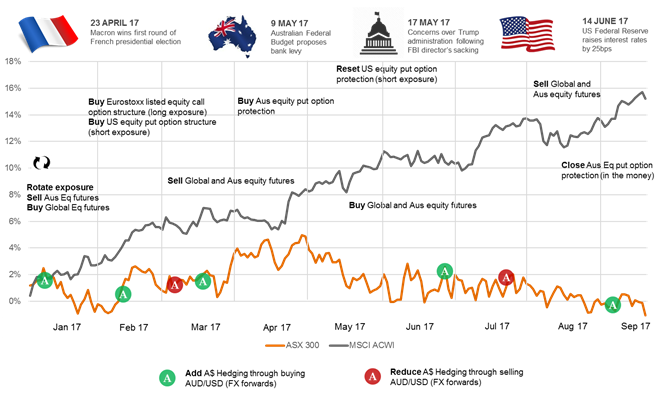Umbrellas for a rainy day: Why options can be better than cash to manage downside risks
Downside protection strategies
Downside protection strategies aim to reduce the probability and the magnitude of losses in a portfolio if markets fall 1. Investors can manage downside risks by:
- Diversifying away from traditional shares and bonds into alternative assets and strategies;
- Reducing exposure to risk assets physically using cash and short term money market instruments; or
- Changing the overall portfolio’s exposures using derivatives such as options, futures and forward contracts.
Options can be more efficient and cost effective than cash
Some market participants (including professional fund managers and retail investors alike) in Australia are holding high levels of physical cash 2 in their portfolios in wait for more compelling buying opportunities should markets correct and pull back. While this may be simple to understand, selling physical exposures (such as shares) and holding cash is a blunt instrument that can involve significant opportunity cost. This is because the exact timing of significant market movements can be hard to predict
In our real return funds at Russell Investments, we take a more dynamic and nuanced approach. Like having umbrellas for a rainy day, options work like an insurance policy that can help when markets fall. The benefits of using options to manage downside risk are timeliness, lower cost and portfolio precision:
- Timeliness. Investors can quickly implement a tactical view on current market valuations. Instead of having to line up transactions using physical assets, which can take up to 3 days, investors can express their view by trading immediately.
- Lower cost. When market volatility is low, options are cheaper to transact than compared to buying and selling cash and physical securities.
- Portfolio precision. Investors can also express both positive and negative views on a wide array of asset classes, regions and sectors, which are sometimes not possible using physical assets alone, e.g. currency views.
Example: How we employed options to manage downside risks in US share markets
After rigorous debate drawing on the quantitative and qualitative insights of Russell Investments’ global strategist and portfolio manager teams, we believe US share markets are increasingly overpriced and want to limit the impact of potential downside losses. We purchase put options on the S&P 500 Index, especially when the market remains upbeat and is pricing ‘insurance’ cheaply (implied market volatility is low). We can implement this immediately using Russell Investments’ 24 hour trading desk in multiple timezones.
Similarly, we can implement views on other regional shares (e.g. positive views on the European markets), as well as bond, currency and other asset markets which have derivative instruments available. Figure 1 summarises how we have dynamically managed our portfolio exposures to global, US, European and Australian share markets and currencies.
Figure 1: Dynamic implementation of market views using options and derivatives in 2017

Source: Russell Investments, Datastream. S&P/ASX 300 Accumulation Index, MSCI All Countries World Accumulation Index.
Index returns represent past performance, are not a guarantee of future performance, and are not indicative of any specific investment. Indexes are unmanaged and cannot be invested in directly.
1For more details, see Russell Investments’ Downside protection: what, why, who, how and when? October 2017.
2Cash and cash equivalents such as short term liquid money market securities or term deposits.